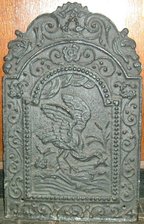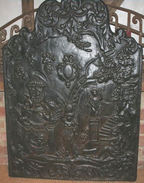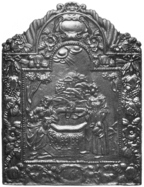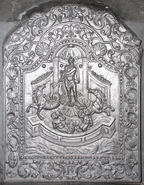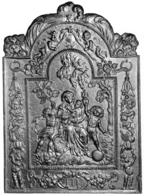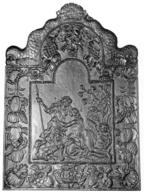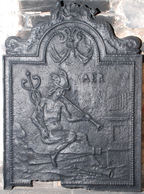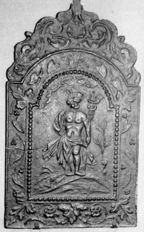-
82
Description: 'Dutch' style; arched rectangular shaped central panel, bead on fillet edging, naturalistic scene of a heron with wings extended catching a fish, water below, clouds above, plants in background; arched rectangular shaped border, fillet edging, symmetrical scrolled tendril pattern; at bottom, two looped 'W' figures between date split corners; on top, symmetrical scrolled foliage. A single central vertical plankline.
Notes: The image of the heron is taken from a print, by Wenceslaus Hollar c.1658, of an etching by Francis Barlow (c.1626-1704); the style of the date suggests a similar pattern maker to a series of firebacks, of the same date, some bearing a Welsh inscription. All incorporate the looped 'W' motif which may be intended to identify the pattern maker. The small size of this fireback makes it likely that it was intended to be fixed to the back of a grate.
Copies of this fireback are known.
Inscription: 17 24
- Decoration tags:
- 'Dutch' (shape)
- fillet (edging)
- whole carved pattern
- planklines
- pictorial
- text
- animals
Manufactured: in 1724 in England.
Current location: Guildford Museum, Guildford, Surrey, England.
Museum number: G.487 (part of the Guildford Museum museum group)
- Attached to series:
- 1724 series
- British 'Dutch' style firebacks
-
86
Description: Quasi-arched rectangular shape; fillet edging; central female figure with urn on head, above which is an oval cartouche (possibly a mirror); to left, fireplace with basket grate, above which a lobster and another (unidentified) creature bear a covered vase; to right a seated female figure stretches forth her left arm, behind her is a statue of a female figure on a plinth at the foot of a curving flight of stairs; the whole is surrounded by naturalistic rocks and trees, suggesting a grotto.
Notes: An unusually free pictorial decoration.
Copies of this fireback are known.
- Decoration tags:
- rectangular with ornate arch (shape)
- fillet (edging)
- whole carved pattern
- pictorial
- humans
- plants
- objects
Manufactured: in the early-18th century in England.
Current location: in private hands, Hadlow Down, East Sussex, England.
- Attached to series:
- Late pictorial series (all)
- Late pictorial series 4
-
1239
Description: Arched rectangular central panel with bead-on-fillet edging; pictorial scene of Jesus sitting at the well with the woman of Samaria standing opposite, a rural scene behind, trees on each side and clouds with sunrays above; arched rectangular border with fillet edging; central cartouche at top, with festoons of fruit, flowers and leaves suspended on each side from ribbons supported by rings; at the bottom, swirled ribbon around an oval compartment bearing the inscription 'L6C'; on top, a central cartouche from which descend a cornucopia on each side of the arch.
Notes: The scene, seen on many German firebacks and stoveplates, is from St John's gospel, chapter 4; the inscription at the bottom indicates the style of border; other firebacks with the same inscription have the same border; similar inscriptions (e.g. L7C and L8G) indicate different borders.
Copies of this fireback are known.
Inscription: L6C
Manufactured: in the mid- to late-17th century possibly in the Siegerland area of Germany.
Current location: Vreden, Nordrhein-Westfalen, Germany.
Citation: Elling, W. & Winkler-Borck, S., 1992, Ofen- und Kaminplatten (Vreden, Hamaland-Museum).
- Attached to series:
- 'Dutch' LC/G series
-
87
Description: 'Dutch' style; cavetto-canted arched rectangular shaped central panel, double fillet and bead edging, figure of Poseidon/Neptone, trident in right hand, standing on three scallop shells, within a niche with a demi-hemispherical roof and two sloping supporting walls, on either side is a mythical seahorse, below is a walled fountain base with two mermaids at the front; cavetto-canted arched rectangular shaped border with scallop and clam shells separated by swirled foliage, monogram at base between scrolled foliage; on top, scrolled foliage.
Notes: From a design in 'Nouveaux livres de ...Statues [etc.]' (La Haye & Amsterdam 1702-5), by Daniel Marot.
Copies of this fireback are known.
Inscription: EB
- Decoration tags:
- 'Dutch' (shape)
- fillet (edging)
- whole carved pattern
- pictorial
- mythological
- monogram
- text
- animals
- humans
- objects
Manufactured: in the early-18th century in England.
Current location: Hampton Court, Richmond, Greater London, England.
Museum number: 1098 (part of the Royal Collection museum group)
- Attached to series:
- EB series
- British 'Dutch' style firebacks
-
308
Description: Arched rectangular centrel panel with bead on fillet edging; central seated female with an infant in her arms, a swan at her feet and a standing child on each side, the one to her left facing the front and holding aloft a flaming heart, its foot on a ball; the child to her right facing the back, holding aloft a branch in its left hand, all on a ground with a tree behind to the right; arched rectangular border with fillet edging; at the top of the arch a cartouche from which are suspended two ribbons, each held by a putto, from which cascade flowers and fruit, each lower part hung from a ring; two putti are on each side, one climbing on the suspended ribbon, the other at its foot; at the bottom, a cartouche containing the monogram between two clusters of flowers each suspended on a ribbon tied to a scroll; on top, two descending cornucopiae.
Notes: The scene portrays Charity; the same central panel can be seen with different borders, and also exists in other versions.
Copies of this fireback are known.
Inscription: HIS
- Decoration tags:
- 'Dutch' (shape)
- fillet (edging)
- whole carved pattern
- pictorial
- allegorical
- monogram
- text
- humans
Manufactured: in the late-17th century in the Siegerland area of Germany.
Current location: Hampton Court Palace, Richmond, Greater London, England.
Museum number: 1069 (part of the Royal Collection museum group)
- Attached to series:
- 'Dutch' HIS series
- Charity firebacks
-
309
Description: Central panel, cavetto-canted rectangle with arch; bud and annulet edging (in alternate threes); pictorial panel portraying Europa being carried to sea by Zeus, disguised as a bull; two female attendants wave from the right shore; two putti attend, one below with a bow and arrow; trees to right and left; clouds and sun above. Same shaped, fillet-edged border with floral scrolls top and sides; at the bottom, a cartouche bearing EB monogram between oak leaf and acorn fronds; on top, central scallop shell between floral scrolls with dolphin’s heads.
Notes: The central design is closely based on an illustration by Bernard Salomon, first published in a 1557 edition of Ovid’s Metamorphoses and copied in subsequent editions by Virgil Solis (1514-62). The initials, EB, are likely to be those of the pattern maker. The similarity between the execution of this picture and those on firebacks bearing the SHR monogram suggests the possibility of a common source. Ten rivets are the result of later repair.
Copies of this fireback are known.
Inscription: EB
- Decoration tags:
- 'Dutch' (shape)
- fillet (edging)
- whole carved pattern
- pictorial
- mythological
- monogram
- text
- animals
- humans
Manufactured: in the early-18th century in England.
Current location: Hampton Court Palace, Richmond, Greater London, England.
Museum number: 1107 (part of the Royal Collection museum group)
- Attached to series:
- EB series
- British 'Dutch' style firebacks
-
310
Description: Arched rectangular central panel with bead edging; pictorial scene of Venus, naked and kneeling, and Adonis, standing, holding a spear in his left hand, with Cupid to the left, and a hound and a quiver of arrows below to the right; arched rectangular border with fillet edging; descending swags of fruit and seashells enclosing the central panel; inscription in an oval cartouche at the bottom; on top, a Holy Roman Imperial crown between two mirrored dolphins, heads downward.
Notes: The scene is based on the painting (c.1635) of Venus and Adonis by Peter Paul Rubens; the initials, L8G, denote the style of border - other firebacks having the same inscription have the same border - and other borders are denoted by similar inscriptions (e.g. L6C and L7C). Von den Driesch (p.520) illustrates the same central image within an L7C border.
Copies of this fireback are known.
Inscription: L8G
- Decoration tags:
- 'Dutch' (shape)
- fillet (edging)
- whole carved pattern
- pictorial
- mythological
- text
- humans
Manufactured: in the late-17th century in the Siegerland area of Germany.
Current location: Hampton Court Palace, Richmond, Greater London, England.
Museum number: 1042 (part of the Royal Collection museum group)
- Attached to series:
- 'Dutch' LC/G series
- 'Dutch' Venus and Adonis firebacks
-
98
Description: Arched rectangular shaped central panel with bead edging; naked figure of Mercury/Hermes with winged helmet (petasos), holding a snake-entwined staff (caduceus); he is sitting astride a pair of bellows and blowing a straight trumpet; a twice-bent trumpet lies at his feet; the bellows are pumping air into an organ; to the right of his head is the word, AER (air - Latin); above is a swag of drapery; outside the panel is a narrow border of the same shape with fillet edging; the fireback is surmounted by a scallop shell between two outward-facing sea serpents.
Notes: One of a series of firebacks symbolising the four elements.
Copies of this fireback are known.
Inscription: AER
- Decoration tags:
- 'Dutch' (shape)
- fillet (edging)
- whole carved pattern
- mythological
- allegorical
- text
- humans
- objects
Manufactured: in the mid- to late-17th century in England.
Current location: Nymans, Staplefield Road, Handcross, Slaugham, West Sussex, England.
Museum number: 1206021 (part of the National Trust museum group)
- Attached to series:
- 'Dutch' Miscellaneous Firebacks
- Elements firebacks
-
104
Description: 'Dutch' style; arched rectangular shaped central panel with arch at top; bead edging; female figure with staff and fan in a garden, inscription DER MITAG below figure ; similarly shaped border of Corinthian columns and floral decoration; symmetrical serpents on top.
Notes: The inscription means NOON; identified from a clearer version in the collection of the Haardplatenmuseum, Klarenbeek, Netherlands. The representations in human form of various virtues and vices in Iconologia, by Cesare Ripa, first published in the early 17th century but republished in different editions many times subsequently, formed the basis of the subject matter of several firebacks, mostly cast from continental originals, that became popular in England from the late 17th century.
Copies of this fireback are known.
Inscription: DER MITAG
- Decoration tags:
- 'Dutch' (shape)
- fillet (edging)
- whole carved pattern
- pictorial
- allegorical
- text
- humans
Manufactured: in the mid- to late-17th century possibly in the Siegerland area of Germany.
Current location: Haslemere Educational Museum, Haslemere, Surrey, England.
(part of the Haslemere Educational Museum museum group)
- Attached to series:
- 'Dutch' Miscellaneous Firebacks
-
111
Description: 'Dutch' style; arched rectangular shaped central panel with bead edging, semi-naked figure holding a caduceus in his left hand, standing on a mound with a tree to the right and clouds above; arched rectangular shaped border with fillet edging and an ivy and acanthus leaf pattern; on top an arrangement of swirled foliage.
Notes: The figure is Hermes/Mercury, one of a set of 'Eight Deities' engraved by Hendrick Goltzius (1592), after Polidoro da Caravaggio. Formerly part of the Ade Collection (from Grove Hill, Hellingly, Sussex).
Copies of this fireback are known.
- Decoration tags:
- 'Dutch' (shape)
- fillet (edging)
- whole carved pattern
- mythological
- humans
Manufactured: in the mid- to late-17th century in England.
Current location: Hastings Museum and Art Gallery, John's Place, Bohemia Road, Hastings, East Sussex, England.
Museum number: HASMG: 1952.51.34 (LA 782) (part of the Hastings Museum museum group)
- Attached to series:
- British 'Dutch' style firebacks
- Eight Deities series
